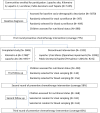Albendazole and ivermectin for the control of soil-transmitted helminths in an area with high prevalence of Strongyloides stercoralis and hookworm in northwestern Argentina: A community-based pragmatic study
- PMID: 28991899
- PMCID: PMC5648268
- DOI: 10.1371/journal.pntd.0006003
Albendazole and ivermectin for the control of soil-transmitted helminths in an area with high prevalence of Strongyloides stercoralis and hookworm in northwestern Argentina: A community-based pragmatic study
Abstract
Background: Recommendations for soil-transmitted helminth (STH) control give a key role to deworming of school and pre-school age children with albendazole or mebendazole; which might be insufficient to achieve adequate control, particularly against Strongyloides stercoralis. The impact of preventive chemotherapy (PC) against STH morbidity is still incompletely understood. The aim of this study was to assess the effectiveness of a community-based program with albendazole and ivermectin in a high transmission setting for S. stercoralis and hookworm.
Methodology: Community-based pragmatic trial conducted in Tartagal, Argentina; from 2012 to 2015. Six communities (5070 people) were enrolled for community-based PC with albendazole and ivermectin. Two communities (2721 people) were re-treated for second and third rounds. STH prevalence, anemia and malnutrition were explored through consecutive surveys. Anthropometric assessment of children, stool analysis, complete blood count and NIE-ELISA serology for S. stercoralis were performed.
Principal findings: STH infection was associated with anemia and stunting in the baseline survey that included all communities and showed a STH prevalence of 47.6% (almost exclusively hookworm and S. stercoralis). Among communities with multiple interventions, STH prevalence decreased from 62% to 23% (p<0.001) after the first PC; anemia also diminished from 52% to 12% (p<0.001). After two interventions S. stercoralis seroprevalence declined, from 51% to 14% (p<0.001) and stunting prevalence decreased, from 19% to 12% (p = 0.009).
Conclusions: Hookworm' infections are associated with anemia in the general population and nutritional impairment in children. S. stercoralis is also associated with anemia. Community-based deworming with albendazole and ivermectin is effective for the reduction of STH prevalence and morbidity in communities with high prevalence of hookworm and S. stercoralis.
Conflict of interest statement
The authors have declared that no competing interests exist.
Figures






Similar articles
-
Serious limitations of the current strategy to control Soil-Transmitted Helminths and added value of Ivermectin/Albendazole mass administration: A population-based observational study in Cameroon.PLoS Negl Trop Dis. 2020 Nov 3;14(11):e0008794. doi: 10.1371/journal.pntd.0008794. eCollection 2020 Nov. PLoS Negl Trop Dis. 2020. PMID: 33141853 Free PMC article.
-
Impact of mass drug administration with ivermectin, diethylcarbamazine, and albendazole for lymphatic filariasis on hookworm and Strongyloides stercoralis infections in Papua New Guinea.PLoS Negl Trop Dis. 2025 Mar 10;19(3):e0012851. doi: 10.1371/journal.pntd.0012851. eCollection 2025 Mar. PLoS Negl Trop Dis. 2025. PMID: 40063867 Free PMC article. Clinical Trial.
-
Strongyloides stercoralis and hookworm co-infection: spatial distribution and determinants in Preah Vihear Province, Cambodia.Parasit Vectors. 2018 Jan 12;11(1):33. doi: 10.1186/s13071-017-2604-8. Parasit Vectors. 2018. PMID: 29329561 Free PMC article.
-
Ivermectin and albendazole coadministration: opportunities for strongyloidiasis control.Lancet Infect Dis. 2022 Nov;22(11):e341-e347. doi: 10.1016/S1473-3099(22)00369-3. Epub 2022 Jul 15. Lancet Infect Dis. 2022. PMID: 35850127 Review.
-
Impact of preventive chemotherapy on Strongyloides stercoralis: A systematic review and meta-analysis.PLoS Negl Trop Dis. 2023 Jul 10;17(7):e0011473. doi: 10.1371/journal.pntd.0011473. eCollection 2023 Jul. PLoS Negl Trop Dis. 2023. PMID: 37428815 Free PMC article.
Cited by
-
Intestinal parasites in children from native communities of Salta, Argentina.Colomb Med (Cali). 2024 Mar 30;55(1):e2025948. doi: 10.25100/cm.v55i1.5948. eCollection 2024 Jan-Mar. Colomb Med (Cali). 2024. PMID: 39435011 Free PMC article.
-
The Relationship Between Soil-Transmitted Helminth Infections and Environmental Factors in Puerto Iguazú, Argentina: Cross-Sectional Study.JMIR Public Health Surveill. 2023 Nov 7;9:e41568. doi: 10.2196/41568. JMIR Public Health Surveill. 2023. PMID: 37934580 Free PMC article.
-
Asymptomatic Strongyloidiasis among Latin American Migrants in Spain: A Community-Based Approach.Pathogens. 2020 Jun 24;9(6):511. doi: 10.3390/pathogens9060511. Pathogens. 2020. PMID: 32599871 Free PMC article.
-
Soil-Transmitted Helminthiasis in Children from a Rural Community Taking Part in a Periodic Deworming Program in the Peruvian Amazon.Am J Trop Med Hyg. 2019 Sep;101(3):636-640. doi: 10.4269/ajtmh.18-1011. Am J Trop Med Hyg. 2019. PMID: 31309921 Free PMC article.
-
Seroprevalence of Strongyloides stercoralis, human T-lymphotropic virus, and Chagas disease in the Peruvian Amazon: a cross-sectional study.Rev Inst Med Trop Sao Paulo. 2024 Dec 16;66:e73. doi: 10.1590/S1678-9946202466073. eCollection 2024. Rev Inst Med Trop Sao Paulo. 2024. PMID: 39699511 Free PMC article.
References
-
- World Health Organization. Soil Transmitted Helminthiases. Eliminating soil-transmitted helminthiases as a public health problem in children Progress report 2001–2010 and strategic plan 2011–2020. Geneva, Switzerland: WHO Press; 2012.
-
- Bethony J, Brooker S, Albonico M, Geiger SM, Loukas A, Diemert D, et al. Soil-transmitted helminth infections: ascariasis, trichuriasis, and hookworm. Lancet. 2006;367: 1521–32. doi: 10.1016/S0140-6736(06)68653-4 - DOI - PubMed
-
- World Health Organization. Working to overcome the global impact of neglected tropical diseases First WHO report on neglected tropical diseases. Crompton DWT, editor. France: WHO Press; 2010.
-
- Olsen A, van Lieshout L, Marti H, Polderman T, Polman K, Steinmann P, et al. Strongyloidiasis—the most neglected of the neglected tropical diseases? Trans R Soc Trop Med Hyg. 2009;103: 967–72. doi: 10.1016/j.trstmh.2009.02.013 - DOI - PubMed
-
- Krolewiecki AJ, Lammie P, Jacobson J, Gabrielli AF, Levecke B, Socias E, et al. A Public Health Response against Strongyloides stercoralis: Time to Look at Soil-Transmitted Helminthiasis in Full. PLoS Negl Trop Dis. 2013;7: 1–7. doi: 10.1371/journal.pntd.0002165 - DOI - PMC - PubMed
MeSH terms
Substances
LinkOut - more resources
Full Text Sources
Other Literature Sources

